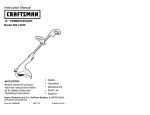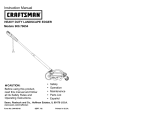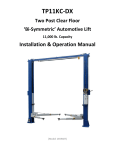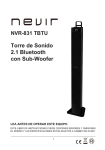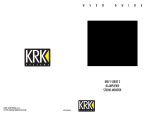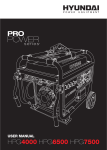Download Vivitar ViviCam 2750 Digital Camera
Transcript
Vivicam 2750 User Manual English 021009 Warranty Policy This camera is under warranty for one full year from the date of purchase by the orignal purchaser. In case of defects in materials or workmanship, we will replace or repair the camera free of charge. This warranty applies to the camera only. This warranty does not include batteries, or other accessories which have not been manufactured by our company. This warranty will not be honored if the camera has been mishandled or tampered with, or altered by anyone other than the manufacturer. Other than for the warranty herein, we are not responsible for loss, damage, or inconvenience of any kind. A defective camera being returned under warranty must be accompanied by a brief description of the difficulties encountered and also by a proof of purchase with the date of purchase clearly indicated. All related transportation costs and insurances are at the ownerís expense. Any alteration of this warranty cannot be made without Pretecís written approval. FCC Notice This equipment has been tested and found to comply with the limits for a Class B digital device, pursuant to part 15 of the FCC Rules. These limits are designed to provide reasonable protection against harmful interference in commerical installation. This equipment generates, uses and can radiate radio frequency energy and if not installed and used in accordance with the instructions, may cause harmful interference to radio communications. However, there is no guarentee that interference will not occur in a particular installation. If this equipment does cause harmful interferece to radio or television reception, detectable by turning the equipment in question off and on, the user is encouraged to try to correct the intereference by one or more of the following measures: Reorient or relocate the receiving antenna; Increase the distance between the equipment and the receiver; Connect the equipment to an outlet on a different circuit than that which the receiver is connected to; Or consult the dealer or an experienced radio/TV technician for help. 1 CAUTION Do not place this camera in damp or dusty location. This may cause a fire or electric shock. Do not place this camera in a location affected by oil fumes or steam, such as near a cooking stove or humidifier. This may cause a fire or electric shock. Do not leave this camera in places subject to extremely high temperatures, such as in a sealed vehicle or in direct sunlight. Exposure to high temperatures may adversely affect the camera case and internal components and cause a fire. Do not cover or wrap the camera or the AC power adapter with a cloth or quilt. This may cause heat to build up and distort the case or cause a fire. Always use the camera and its accessories in wellventilated locations. Take care that the camera is not bumped when it is being moved. This may cause the camera to malfunction. Do not move the camera while it is switched on. (if you are using the AC power adapter, unplug the adapter from the AC power outlet after you have switched off the camera.) Then ensure that any connector cords or cables to other devices are disconnected before moving the camera, Failure to do so may damage the cords or cables and cause a fire or electric shock. When handling the camera, always unplug it from the power source (batteries or AC power adapter) for safety. (if you are using the AC power adapter, unplug the adapter from the AC power outlet after you have disconnected the camera.) Failure to do so could result in an electric shock. 2 CAUTION When leaving the camera unused for long periods, such as during a vacation, always unplug the camera from the power source (batteries or AC power adapter ) for safety. (if you are using the AC power adapter, unplug the adapter from the AC power outlet after you have disconnected the camera.) Failure to do so could result in a fire. Contact your dealer or local authorized service facility to request cleaning of the interior of the camera every two years. Allowing dust to accumulate in the camera for long periods without cleaning the camera interior may cause a fire or electric shock. Cleaning is best performed prior to seasonal periods of high humidity. Consult with your dealer or local authorized service facility for information on the cost of cleaning your camera. Do not use batteries other than those specified for use with your camera. The use of unsuitable batteries may result in the batteries splitting or leaking and causing a fire, injury, or soiling of the battery compartment. When fitting a battery into the camera, check the polarity markings on the battery ( + and )to ensure that you insert the battery correctly. Incorrect battery polarity may result in the batteries splitting or leaking and causing a fire, injury, or soiling of the battery compartment. Remove the batteries if the camera will not be used for an extended period of time. The batteries may leak and cause a fire, injury or soiling of the battery compartment. If the batteries leak, clean and wipe the battery compartment carefully and install new batteries. Wash your hands carefully if you touch the battery fluid. 3 WARNING Unplug from power socket. Do not use this camera when it is emitting smoke, is unusually hot to the touch, is emitting any unusual odor or noise, or is in any other abnormal state. Use of the camera in any of these situations may cause a fire or electric shock. Stop using the camera immediately, turn the camera off, and then disconnect the power source (batteries or AC power adapter). (If you are using the AC power adapter, unplug the adapter from the AC power outlet after you have disconnected the camera.) After checking that smoke is no longer being emitted, contact your dealer or your local authorized service facility and request repairs. never attempt to repair this camera yourself as this is dangerous. Do not use the camera if any water has entered the camera. Switch the camera off, and then disconnect the power source (batteries or AC power adapter). (if you are using the AC power adapter, unplug the adapter from the AC power outlet after you have disconnected the camera.) Then contact your dealer or your local authorized service facility. Do not continue to use the camera as this may cause a fire or electric shock. Do not use the camera if any foreign objects have entered the camera. Turn the camera off, and then disconnect the power source (batteries or AC power adapter). (if you are using the AC power adapter, unplug the adapter from the AC power outlet after you have disconnected the camera.) Then contact your dealer or your local authorized service facility. Do not continue to use the camera as this may cause a fire or electric shock. If the camera has been dropped or the camera case has been damaged, switch the camera off, and then disconnect the power source (batteries or AC power adapter). (if you are using the AC power adapter, unplug the adapter from the AC power outlet after you have disconnected the camera.) Then contact your dealer or your local authorized service facility. Do not continue to use the camera as this may cause a fire or electric shock. 4 WARNING Do not place the camera in unstable locations such as on a wobbly table or sloping surface where the camera may fall or tip over and cause injury. Take care that the camera is not exposed to moisture and that water does not get into the camera. Take particular care when it is raining or snowing or when you are using the camera at the beach or near water. Water in the camera may cause a fire or electric shock. Do not insert or drop metallic or inflammable foreign objects into the camera through access points such as the Compact Flash card slot. This may cause a fire or electric shock. Do not attempt to modify this camera. This may cause a fire or electric shock. Do not disassemble Do not remove the camera casing. This may cause an electric shock. Internal inspection, maintenance and repairs should be carried out by your dealer or local authorized service facility. Do not use in wet areas. Do not use this camera in the bathroom. This may cause a fire or electric shock. Do not touch Do not touch the power plug during a thunderstorm if you are using the AC power adapter. This may cause an electric shock. 5 WARNING Never use this camera, look through the viewfinder, or watch the LCD (liquid crystal display)while you are operating a moving car, motorcycle or bicycle. This may cause a traffic accident. Do not attempt to charge the alkaline battery. This may cause the battery to split or leak, causing fire or injury. Do not carry or store a battery with objects such as metal pens, necklaces, coins or hairpins. This could short circuit the positive + and negative poles of the battery. This may cause the battery to split or leak, resulting in fire or injury. Do not heat or attempt to disassemble a battery, and do not place a battery in water or in a fire. Any of these may cause the battery to split or leak, cause fire or injury. Do not subject a battery to strong impacts, such as hitting it with a hammer, stepping on it or dropping it. Any of these may cause the battery to split or leak, cause fire or injury. Use only the specified batteries or AC power adapter specified for use with this camera. The use of other power sources may cause a fire. 6 Contents Getting Started ...............................................................................9 What’s Inside: ...........................................................................................9 System Requirements (Windows) ..................................................10 System Requirements (Macintosh) ................................................10 Getting to know the camera ................................................11 Using the camera .............................................................................12 Power Supply ..........................................................................................12 Inserting Batteries ...............................................................................12 Flash Memory .........................................................................................13 Extended Flash Memory ...............................................................13 Using AC Power ...................................................................................14 Auto Power Off .....................................................................................14 Taking Pictures ..................................................................................15 Using the LCD Display ............................................................16 Adjusting LCD Brightness ...........................................................16 Viewing Pictures on the LCD ....................................................16 Viewing Thumbnails ...........................................................................17 Menu Mode ............................................................................................17 Erasing Pictures from Memory .......................................19 7 Defining Picture Quality ........................................................19 Using the Flash ..................................................................................20 Using the Self-Timer ...................................................................20 Memory Full ..........................................................................................20 Connecting to Your Computer .........................................21 The Digital Interface ....................................................................21 Installing Capture Software ...............................................22 Appendix 1 : LCD Icons ...........................................................23 Appendix 2 : Record Mode Icons ................................23 Appendix 3 : Digital Camera Specifications ..24 Appendix 4 : Specifications and Operation of FotoPrint 600 ..........................................25 8 Getting Started Congratulations on purchasing your new Digital Camera. This camera is a state-of-the-art camera bringing to you the ease of use of traditional cameras combined with such high-tech functionality as full-color LCD (Liquid Crystal Display) photo previewing, allowing you to immediately see the pictures you have just taken; a built-in, non-expiring flash, up to 512k bytes or more of digital memory for storing your pictures; and an autoflash sensor, which automatically detects whether the flash should be engaged or not while taking a photo. Once you have finished taking your pictures, and have uploaded them to a computer, you can then use image editing software to enhance them before sending them off to print or you can print the pictures you took through the direct printing interface. What’s Inside: ■ ■ ■ ■ ■ ■ 1 Digital Camera Quickstart Guide Owner’s Manual Serial cable ( PC or Macintosh.) Image editing software 4 x AA alkaline batteries Optional Items: ■ ■ ■ 6.0V power adaptor FotoPrint 600 direct printing interface (See as appendix:4) 2MB,4MB,8MB,16MB compact flash card. CD-ROM Contents ■ ■ Photo image editing software - allows you to quickly and easily touch up any photo captured with your camera. TWAIN Acquire module - lets you download pictures from all TWAINcompliant devices straight into your computer. 9 System Requirements (Windows) ■ ■ ■ ■ ■ ■ Personal computer with minimum 486, 33MHz processor Microsoft Windows operating system (version 3.1 and higher, Windows95 Windows98 ready) 8MB or more of RAM 30MB of hard disk space available serial port and CD-ROM drive color display (800x600 24-bit or higher recommended) System Requirements (Macintosh) ■ ■ ■ ■ ■ ■ Power PC or above System 7.5 or higher 8MB or more of RAM 30MB of hard disk space available serial port and CD-ROM drive color display (800x600 24-bit or higher recommended) 10 Getting to know the camera 1 Macro/Normal Mode switch 5 Erase 2 Icon mode 3 Multiple Display 6 7 Menu Play/Record 4 Shutter Release 8 Power 9 View Finder 10 Display 11 Forward/Self-Timer 12 Backward/Flash 13 LCD Display 11 Using the camera Power Supply This camera features a two-way power supply that lets you use either batteries (AA-size Alkaline) or a household AC current. Inserting Batteries 1 Place your thumb on the battery door. 2 Slide the battery door away from the camera. Botton view of the camera 3 Insert the batteries as indicated on the inner side of the battery door. Notes: ■ If you are not going to be using the camera for an extended length of time, then you should remove the batteries to prevent leaks or corrosion. Never use manganese batteries. ■ ■ ■ Never mix old and new batteries. Low temperature (under 0 c) may reduce the output efficiency of batteries ■ 12 , then shortening the operation time of camera. The recommend battery is PANASONIC ALKALINE or rechargable battery. Battery Life Indicator When the camera has sufficient power, the Low Power icon on the LCD display of the camera remains dark. When the power is low, the Low Power icon is visible to indicate that the batteries are weak and need to be replaced. Also, do not use the Flash or Auto-Flash features while battery power is low. Generally, once the Low Power icon comes on, 10 minutes of operation time is available. (When the batteries are completely dead, the camera will not turn on.) Flash Memory The camera features flash memory for storing image information. This memory does not require electrical power to function, so you will not lose any pictures you took when the camera is turned off or low on power. If the batteries go dead, simply insert a new set or connect the AC power supply and you will be able to retrieve and view the previously captured photos. Extended Flash Memory You can extend the capabilities of your camera by adding the Compact Flash Memory card accessory to it. This card is a removable ATA-compatible memory device that gives your camera additional memory. With 2M memory, for example, you can take 32 extra pictures in Normal mode, or 16 pictures in Fine mode. To insert the Compact Flash Memory card, open the card slot on the bottom of the camera and insert the card with the back side facing you and heading inward. Next, close the card slot cover and the camera memory is updated automatically. To remove the card, push the Eject key. 13 Using AC Power To run the camera on standard AC power, use the 6.0V/2.5AC Adaptor. ■ ■ ■ Always be sure to use the AC adaptor which comes with the camera; or optional from the manufacture. Any other inappropriate adaptor may cause damage to the camera which is not covered under the warranty. Grasp the adaptor, not the cord, when unplugging the adapter from a wall socket. If the power cord becomes damaged (exposed wires, disconnection, etc.) please purchase a new AC adaptor. Use of a damaged cord may cause fire or electrical shock. ■ Switch off the power to the AC adaptor before unplugging it from the wall socket. Auto Power Off Power automatically turns off whenever you do not perform any camera operations for a specific interval of time. You can set the interval up to 99 minutes. 14 Taking Pictures 1 Turn the camera on by pressing the Power button for at least one second. When the camera is activated, you will 1 see a small LED light on beside the Viewfinder. If you would like to use the LCD display, you can turn it on by pressing the Display button. 2 Set the camera to Normal if the object or view is 40cm or more away from 2 the camera, and to Macro if the object or view is between 10 and 30cm away. This is set using the Macro/Normal mode switch. Then press the Play/ Rec button to set the camera to Recording mode. Note: Image Storage capacity is as follows: With 512K memory, in Normal mode - 8 images; in Fine mode - 4 images, With 2MB memory in Normal mode -32 images; in Fine mode-16 images. 3 3 Using the LCD display, or the viewfinder, compose your image. When you are ready, press the Shutter Release button. 4 The LCD screen pauses and in a few seconds a static copy of the image appears while the camera saves it to memory. Once the LCD resumes previewing, you can take another picture or switch to the PLAY mode to view the image you just recorded. 15 Using the LCD Display Using the built-in Liquid Crystal Display (LCD), you can view pictures in a few seconds after capturing them. The following section describes how to use the LCD and its various functions. Note: You need not activate the LCD to take pictures - however, using it while capturing shortens the lifespan of your batteries. Note: To remove all icons from the LCD display, press the Icon mode button on top of the camera. Pressing it a second time returns all icons to the screen. Adjusting LCD Brightness The LCD display comes with the a brightness feature that allows you to change how images are displayed on the LCD screen. To turn the brightness of the LCD either up or down, turn the camera over so that the bottom side is facing up. In the center of the camera’s bottom side is a radial dial. Turning the dial with your fingernail or a small coin adjusts the brightness up and down. Viewing Pictures on the LCD The Display button turns the LCD display on, allowing you to see each picture as it is taken. 1 After turning on the Power, press the Play/Record button to switch to the Play mode. The LCD display warms up and then displays the last picture taken. If there are no pictures in the camera, then a message displays informing you of this. 16 2 Press the Forward or Backward buttons to scroll through the pictures stored in memory. 3 Press the Display button again to turn off the LCD display. Viewing Thumbnails In addition to previewing single frames on the LCD screen, you can also view 9 thumbnail images of the pictures in the storage queue. This gives you the advantage of being able to see at once all the pictures you have already taken rather than having to scroll through them all one by one. To view image thumbnails: 1 Press the Play button. 2 Next, press the Multiple Display button to enter the Thumbnail mode (if there are more pictures than thumbnails, use the Self/+ or Flash/- to scroll to the next or previous screens.) 3 Press the Multiple Display button again to exit Thumbnail mode. Menu Mode To enter the Menu Mode, press the Menu button and release it. The LCD image is replaced by the built-in functions menu containing options and features to set the camera status. To use the functions, simply select the one you want to engage with the Self/+ or Flash/- buttons, and then press the Shutter Release button. The seven functions in Menu Mode are: 17 ■ Move To Card - copy the images in the internal memory to the ■ Erase All - erases all the image in the built Flash Memory and in the Compact Flash Card , if you have it inserted into the card slot. Memory Card. Before the erase procedure takes place, you will be asked to confirm it first. ■ Set Date/Time - allows you to set the time and date that appear on your pictures. Use the Shutter Release button to increase the number in the selected field, and the Self/+ or the Flash/- button to select a field. Selecting the OK option to accept the setting or the Exit to return to the main menu. ■ Auto Power Off - allows you to set the interval for auto shut off. Press the Shutter Release button to increase the interval of shut off time. Selecting the OK option to accept the setting or the Exit to return to the main menu. Note that you can set the interval up to 99 minutes. ■ Auto Play - defines the interval between images when viewing them on the LCD screen. Press the Shutter Release button to increase the auto play interval. Selecting the OK option to accept the setting or the Exit to return to the main menu. If no value is set then the images must be scrolled manually in Play mode using either the Self/+ or Flash/- buttons. ■ Image Quality - toggles between Normal and Fine mode. With 512 K memory, Normal allows you to capture up to 8 images at standard compression, while Fine allows you to capture up to 4 uncompressed images. All images are captured at 640x480 monitor resolution. With 2MB memory,32 images will be captured in Normal mode, while 16 images will be captured in Fine mode. ■ Lock./Unlock - allows you to lock the current image being displayed in the LCD so that it can not be erased. You can also unlock currently locked images. 18 Erasing Pictures from Memory The Erase button allows you to remove any unwanted pictures from the memory. To remove pictures, please note that the LCD must be turned on. 1 After turning the camera on, press the Play/Record button to enter the PLAY mode. 2 To remove a picture, scroll to the picture then press the erase button . A dialog asking you to confirm the deletion appears on the LCD. Press the Self/+ button for Yes and the Flash/- button for No. After erasing a picture, exit to the preview screen by pressing the Play/Record button again. 3 To erase all the pictures in memory, press the Menu button. When the options screen appears, cycle through them using the Self/+ button or the Flash/- button until you come to the Erase All icon. Pressing the Shutter Release button reformats both the memory card and flash memory. Defining Picture Quality Your digital camera can take pictures at two different modes: Normal (compressed) and Fine(less compressed). Both modes take pictures at 640 x 480 monitor resolution. Note, however, that your camera can only store 8 images in Normal mode or 4 images in Fine mode with 512K built-in flash memory. (For the 2MB memory built in the camera can store up 32 images in Normal mode or 16 images in Fine mode.) To define your picture quality: 1 Click the Menu button to display the menu options in the LCD display. 2 Using the Self/+ or the Flash/- buttons, cycle through the options until you have selected the Quality icon. 3 Press the Shutter Release button to change the Quality setting. 19 Using the Flash The digital camera has three different flash modes: Auto (the default mode); Fill; and Off. Each of these modes can be accessed via the Flash button on the backside of the camera. ■ Auto - the camera automatically fires the flash when the brightness of ■ the subject or scene is too low. Fill - fires the flash regardless of the brightness levels in the vicinity. However, the strength of the flash varies according to the ambient brightness of your surroundings, so the more light in the area, the lower ■ level of the flash. Off - the flash disengaged no matter what the ambient brightness of the surroundings is. Using the Self-Timer The Self-Timer is handy for creating a delay between the time you press the shutter and the time the picture is taken. You can activate the self-timer by pressing the Self/+ button at anytime in Recording mode. Once engaged, each time you press the shutter release button on top of the camera there is a 10 second delay; this delay is marked by flashing the Self-Timer LED once per second for seven seconds, then twice per second for the last three seconds. Memory Full Once you have taken the number of pictures allowed by the camera you must erase them before capturing new ones. To save pictures, transfer them from the camera to your computer via the appropriate cable (PC or MAC) and the COM port on your computer. When your camera memory is full, the green memory light will flash every one second. Also, the LCD screen displays a STORAGE FULL message. 20 Connecting to Your Computer 1 Plug one end of the serial cable into the printer or modem port (on a Macintosh) or a COM port (on a PC). These ports are located at the back of your computer. PC MA C 2 Connect the other end of the serial cable to the camera. 3 Turn on your camera. The Digital Interface The digital camera is capable of two types of output: to video, or to a personal computer. On the left side of the camera are three ports: video ouput, digital output, and Power Supply. The video output connector allows you transmit stored images (640x480 in size) or live video to a standard television set. When the LCD monitor is off, the camera cannot output via this port. To transmit stored images to your television or VCR, simply attach one end of a Video line to the video port of the digital camera, and the other end to the Video port on the television or VCR. 21 To download images to your computer, you need to attach the digital cable to the digital port below the video port, and the other end of the cable to the back of your computer. Once both ends are properly attached, use the software included with this camera to capture the queued images stored within it to your computer’s hard disk, where you can later print them out or edit them in imaging software. The camera’s digital output connector can be set to transmit data at varying baud rates, depending upon the capabilities of your computer. If the camera, while attached to your computer, remains inactive for a given length of time, it shuts down automatically. Installing capture software Once you have got your camera connected to your computer, the next step is to transfer the pictures contained in the camera memory to your computer’s hard disk. However, this cannot be accomplished until your first install the appropriate capture drivers and software. 1 Insert the CD-ROM disc into your CD-ROM drive. 2 If you are in Windows95, select the Run command from the Start menu. When the Run dialog box opens, type E:\setup in the entry line and click OK, where E is the drive letter of your CD-ROM drive. If you are on a Macintosh, double-click the installer icon. 3 The setup program begins - simply follow the on-screen instructions to complete the installation. 22 Appendix 1 : LCD Icons Here’s a summary of all the icons found in the LCD screen of the digital camera, and what they mean. Fill Flash Copy images to memory card No Flash Erase all image in camera memory Auto Flash Erase one image from camera memory Self-Timer on Set time and date Full battery power Set auto shut off Half battery power Set auto play Low battery power Exit Locked file (can’t be erased) Confirm Fine Quality mode Save to Build-in Memory Normal Quality mode Save to Compact Flash Card Appendix 2 : Record Mode Icons Here’s a quick run-down of the icons found in the LCD display screen during Recording: Pictures remain Current date Battery warning Resolution Mode ( -is Fine images) -is Normal images; Self-timer Flash (Auto/Fill/Off) 23 Appendix 3 : Digital Camera Specifications Image Sensor: 1/4" CCD, with 350,000 pixels LCD Display: 1.8" color display with 15 image/sec for movie-like display Image Resolution: 640 x 480 pixels Color: 24-bit (1.67 million colors) Memory: 512 KB (or 2MB) internal flash memory Storage: min. 8 pictures with JPEG data compression in 512K built- in memory. (min. 32 pictures with JPEG data compression in 2MB buitt-in memory.) Lens: Normal:0.5 m-infinity, Macro:20 cm(15-30cm) Built-in Flash: Automatic, fill, off Shutter Speed: 1/30-1/10000 sec (Auto) Connectors: AC adaptor, RS232 serial port, NTSC video output port Weight: 0.67 lbs (with battery) Dimensions: (W)1.9" x (L)5.1" x (H)2.7" Additional: Compact flash card slot Design and specifications are subject to change without notice. 24 Appendix 4 : Specification and Operation of FotoPrint 600 This camera comes with an optional device for images direct printing without connecting any computer. Via connecting with the digital camera and the compatible printers, this device allows you to take a photo and print out immediately at fine photo quality just the same as what you can print from computer. No more hassle of using PC; no more need of developing film, just one single touch and get the photo. Specifications Picture selection Forward and backward selection by using + and - keys Printout mode print single picture,print all pictures, print copies Printout size 2"x1.5" or 4"x3"*,regular or mirror both size LED indicators POWER,PRINTER,PROCESSING LEDs Supported printers HP PCL/5, Epson ESC/P2,or Canon BJC compatible printers Supported DSC Listed digital camera only Dimension (W)2.8” x (L)3.8” x (H)1.4” Weight 0.34 lbs *The printout sizes may vary from different printers. Design and specifications are subject to change without notice. 25


























